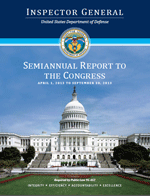So I guess you have to be an old guy like me to remember Keith Jackson, long-time ABC Sportscaster, shouting “Whoa Nellie” but that’s what came to mind as I read the latest on the US Marine Corps audit saga. Apparently GAO has forced the DoD Inspector General to retract the Marine Corp’s clean audit opinion because of problems in the suspense accounts. Here’s a link to an article in Defense News with the details. I have opined on DoD audits on several occasions….first shouting with joy at the accomplishment, then wondering if it really mattered and finally pointing a limp finger towards the Defense Finance and Accounting Service for using “plugs” to fix differences with the Treasury.
but that’s what came to mind as I read the latest on the US Marine Corps audit saga. Apparently GAO has forced the DoD Inspector General to retract the Marine Corp’s clean audit opinion because of problems in the suspense accounts. Here’s a link to an article in Defense News with the details. I have opined on DoD audits on several occasions….first shouting with joy at the accomplishment, then wondering if it really mattered and finally pointing a limp finger towards the Defense Finance and Accounting Service for using “plugs” to fix differences with the Treasury.
So for the record……I told you so! It’s hard for me to believe that the underlying problem has existed for so long without apparent remedy. Here’s a link to a 2005 GAO Report in which GAO finds:
Until DOD complies with existing laws and enforces its own guidance for reconciling, reporting, and resolving amounts in suspense and check differences on a regular basis, the buildup of current balances will likely continue, the department’s appropriation accounts will remain unreliable, and another costly write-off process may eventually be required.
That was almost 10 years ago folks! This has been a continuing report topic for the GAO with various status updates being published throughout the years. Here’s an excerpt from the Summary of a more recent GAO report from December 2011:
Neither the Navy nor the Marine Corps have implemented effective processes for reconciling their FBWT[Funds Balance With Treasury].
Huh? Navy and Marine Corps have been preparing for audit for years and yet it doesn’t appear that they were able to make any progress in fixing a problem identified by GAO way back in 2005 as a key impediment to a clean audit opinion.
So what are the “Suspense Accounts” that are causing such a problem? Technically GAO defines them as “Combined receipt and expenditure accounts established to temporarily hold funds that are later refunded or paid into another government fund when an administrative or final determination as to the proper disposition is made. “ Translation: The place where a transaction is put when the documentation is incomplete so that it can not be assigned to a specific appropriation before it’s written off. To get an idea of scale, in 2005 GAO reports it was an absolute value of $35 Billion. Who knows what it is now? But I point out that it’s just about the amount of the DoD Sequestration hit. Perhaps if they fixed this problem, sequestration wouldn’t have such a bad effect? It seems to be to be awfully hard to go the the Hill and say that $35 Billion in spending cuts would kill the Department, when they are not exactly sure about $35 Billion already sitting around. Those on the defensive will say that the differences are eventually reconciled, but I am skeptical…and since they are already written off, does it really matter? My guess is the money goes straight into the US Treasury Black Hole that all checks drafted to the US Treasury go…you know…that big ever increasing dense ball of greenbacks sitting in the Treasury Department basement.
This problem is precisely why DoD needs to get on with the audit….so they can be sure they know where the money is and provide accurate estimates of the impact of budget cuts. If my kids came to me and said” We need more allowance”, and when asked what did they did with allowance I already gave them they reply, “We don’t know, but we need more!”, I would be highly skeptical of their requirement.
As it stands now, the Army, Navy, Air Force and Marines will spend around $45 Million this year for audits they already know will fail because of the DFAS Suspense Account issues. Why not spend the money to fix that problem before plodding ahead for a pre-ordained result? To be sure it’s a tough problem…after all we have her unable to fix it for 10 years.
Who’s to blame, you ask? Well, there’s enough to go around….DFAS for not fixing it, but also the Services for not taking actions to fix the paperwork before it gets to DFAS. Ultimately, the fault probably rests on the shoulders of all those folks in DoD who improperly enter information at the command level. I would also guess that given the kludge of IT systems required to record transactions, that errors are also introduced between systems, hand-jammed data is incorrectly transferred, and by improperly trained people entering data. This is what is referred to as a “Wicked Problem,” in management parlance. A “Wicked Problem” is defined as ” a problem that is difficult or impossible to solve because of incomplete, contradictory, and changing requirements that are often difficult to recognize. The use of term “wicked” here has come to denote resistance to resolution, rather than evil. Moreover, because of complexity, the effort to solve one aspect of a wicked problem may reveal or create other problems. For more info on “Wicked Problems” you can download the original paper written by C. West Churchman for $30 here.
Is the problem of unresolved transactions so complex that it defies correction? Perhaps given the current architecture within DoD it is, and that alone is reason for the new DCMO to tackle it. A fresh look is needed and the DCMO might be just the person to do it. Right now DoD has an acting DCMO, and given the current political environment, I am not too sure the current nominee, Peter Levine will get confirmed….But for now Mr. Dave Tillotson has the dot. Can someone in an “acting” position draw enough water to tackle this problem? Don’t know, but why not give it a whirl. If and when Mr. Levine gets in the chair, it would be a great legacy to fix this problem once and for all. Given his reputation, I have no doubt that he could fix it.




